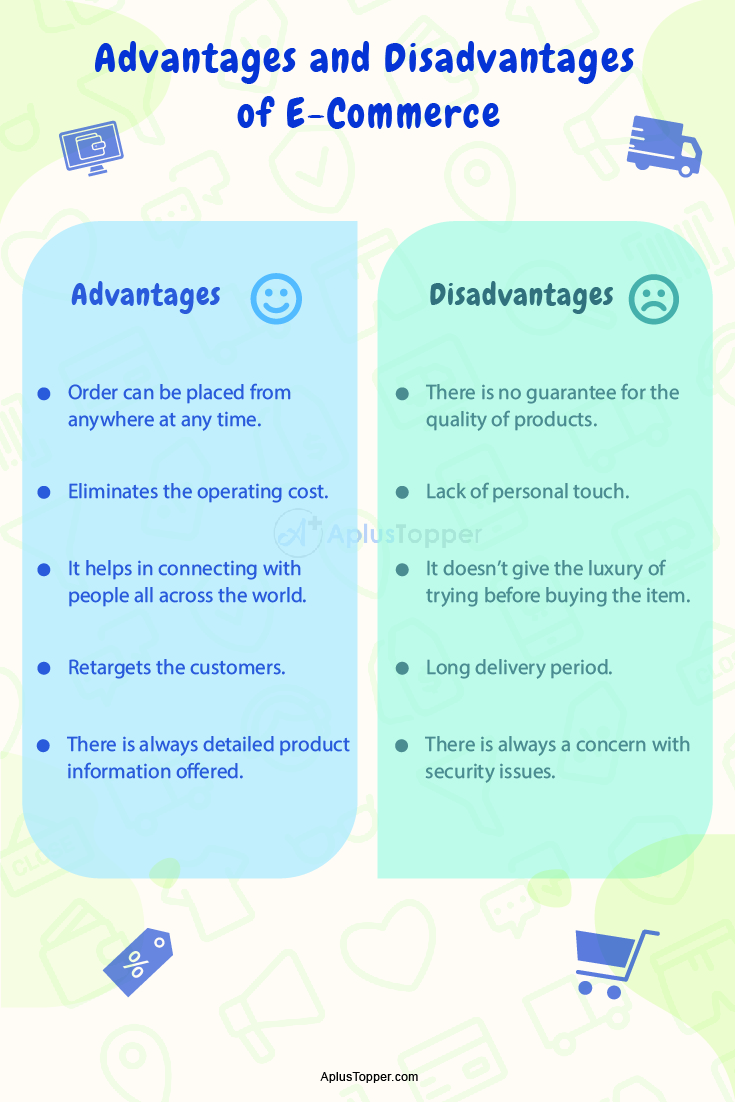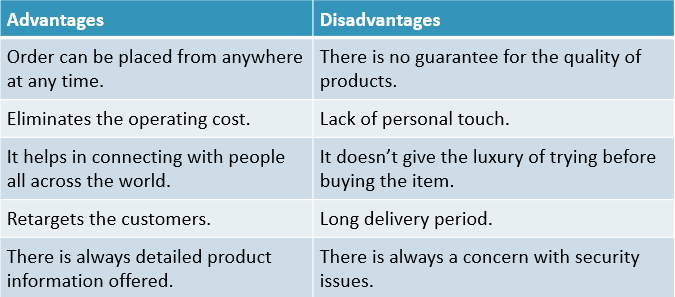Advantages and Disadvantages of E-Commerce: There’s no doubt that the ability to sell online has made a number of businesses profitable and viable. Just like all the other business models, eCommerce also has its pros and cons. It’s essential to get a proper handle on the pros and cons so individuals can be informed when making their strategic decisions.
Students can also find more Advantages and Disadvantages articles on events, persons, sports, technology, and many more.
E-Commerce Advantages and Disadvantages
- What is E-commerce? Advantages and Disadvantages of E-commerce 2021
- Advantages of eCommerce
- Disadvantages of e-Commerce
- Comparison Table for Advantages and Disadvantages of E-Commerce
- FAQs on Pros and Cons of E-Commerce
What is E-commerce? Advantages and Disadvantages of E-commerce 2021
Even nowadays, sometime after the so-called ‘Internet revolution’, E-Commerce remains a relatively new, emerging, and constantly evolving business management and information technology area. Talking in layman’s terms, E-Commerce discussions about the whole process of marketing, selling, delivering orders, and servicing customers over the Internet. Due to the global outbreak of the coronavirus, people have been forced to stay indoors, which has given a significant boost to e-commerce. It has revolutionised the way many companies work.
Advantages of eCommerce
There are a number of prominent and not-so-obvious advantages for doing business on an online platform. Understanding exactly how e-Commerce works can help individuals leverage them to their and their businesses advantage:
- A Larger Market: E-Commerce allows individuals to reach customers all across the country and all around the world. E-Commerce gives business owners the platform to reach people from the comfort of their homes. The customers can make any purchase anytime and anywhere, and significantly more individuals are getting used to shopping on their mobile devices.
- Customer Insights Via Tracking And Analytics: Whether the businesses are sending the visitors to their eCommerce website via PPC, SEO, ads, or a good old postcard, there is a way of tracking the traffic and the consumers’ entire user journey for getting insights into the keywords, marketing message, user experience, pricing strategy, and many more.
- Fast Response To The Consumer Trends And The Market Demands: Especially for the business people who do “drop ship,” the logistics, when streamlined, allow these businesses to respond to the market and the trends of eCommerce and demands of the consumers in a lively manner. Business people can also create deals and promotions on the fly for attracting customers and generate more sales.
- Lower Cost: With the advancement of the eCommerce platforms, it has become very affordable and easy to set up and run an eCommerce business with a lower overhead. Business people no longer need to spend a big budget on TV ads or billboards, nor think about personnel and real estate expenses.
- More Opportunities For “Selling.”: Business people can only offer a limited amount of information about a product in a physical store. Besides that, eCommerce websites give them the space to include more information like reviews, demo videos, and customer testimonials for helping increased conversion.
- Personalised Messaging: E-Commerce platforms give people in business the opportunity to provide personalised content and product recommendations for registering customers. These targeted communications can help in increasing conversion by showing the most relevant content to the visitor.
- Increased Sales Along with Instant Gratification: For businesses selling digital goods, eCommerce allows them to deliver products within seconds of placing an order. This satisfies the needs of the consumers for instant gratification and assists increase sales, especially for the low-cost objects that are often known as “impulse buys.”
- Ability to Scaling Up (Or Down) Quickly Also Unlimited “Shelf Space.”: The growth of any online business is not only limited by the availability of space. Even though logistics might become an issue as one’s business grows, it’s less of a challenge compared to running any brick-and-mortar store. E-Commerce business owners can choose to scale up or down their operation quickly by taking advantage of the non-ending “shelf space,” as a response to the market trends and demands of consumers.

Disadvantages of e-Commerce
Running a business that is e-commerce is not always rainbows and unicorns. There are unique challenges to this business model — learning about them will help business people navigate the choppy waters and avoid common pitfalls.
- Lack of Personal Touch: Some customers appreciate the personal touch they offer when visiting a physical store by interacting with the sales associates. Such personal touch is especially essential for businesses that sell high-end products as customers will want to buy the products and have an excellent experience during the process.
- Lack of Tactile Experience: No matter how good a video is made, customers still can’t feel and touch a product. Not to mention, it’s never an easy task to deliver a brand experience that could often be including the sense of touch, taste, smell, and sound via the two-dimensionality of any screen.
- Product and Price Comparison: With online shopping, customers can compare several products and find the least price. This forces many businesses to compete on price and reduce their profit margin, reducing the quality of products.
- Need for Access to the Internet: This is obvious, but don’t forget that the customers do need access to the Internet before purchasing from any business! As many eCommerce platforms have the features and functionalities which require a high-speed Internet connection for an optimal consumer experience, there’s a chance that companies are excluding visitors who have slow internet connections.
- Credit Card Fraud: Credit card frauds are a natural and growing problem for online businesses. It can lead to many chargebacks, which result in the loss of penalties, revenue, and a bad reputation.
- IT Security Issues: More and more organisations and businesses have fallen prey to malicious hackers who have stolen information of the customers from their databases. This could have financial and legal implications, but it also reduces the company’s trust.
- All the Eggs in One Basket: E-Commerce businesses rely solely or heavily on their websites. Even just some minutes of downtime or technology glitches could be resulting in a substantial revenue loss and customer dissatisfaction.
- Complexity in Regulations, Taxation, and Compliance: Suppose any online business sells to its consumers in different territories. In that case, they’ll have to stick to the regulations in their own countries or states and their consumers’ places of residence. This could be creating a lot of complexities in accounting, taxation and compliance.
Advantages And Disadvantages Of E-Commerce In Tabular Form
| Advantages of E-commerce | Disadvantages of E-commerce |
|---|---|
| 1. Increased reach: E-commerce allows businesses to reach customers across the globe, without the limitations of physical distance. | 1. Cybersecurity risks: Online transactions can be vulnerable to hacking and other cybersecurity threats, putting customer data at risk. |
| 2. Convenience: Online shopping allows customers to shop from the comfort of their own homes, saving time and effort. | 2. Lack of personal interaction: E-commerce lacks the personal touch that brick-and-mortar stores offer, which can be a disadvantage for some customers. |
| 3. Lower costs: E-commerce eliminates many of the costs associated with running a physical store, such as rent, utilities, and staffing. | 3. Shipping costs: Customers may have to pay extra for shipping, which can be a disadvantage for those who are price-sensitive. |
| 4. Increased sales: E-commerce can lead to increased sales by reaching a larger customer base and offering personalized recommendations. | 4. Returns and refunds: Handling returns and refunds can be more complicated for e-commerce businesses, especially for products that are difficult to ship or require special handling. |
| 5. Data collection: E-commerce allows businesses to collect and analyze customer data, which can be used to improve marketing strategies and customer experiences. | 5. Dependence on technology: E-commerce businesses rely heavily on technology, which can be a disadvantage if there are technical issues or system failures. |
| 6. 24/7 availability: E-commerce allows businesses to be open 24/7, providing customers with the flexibility to shop at any time. | 6. Lack of sensory experience: E-commerce lacks the sensory experience of physical stores, which can be a disadvantage for products that require sensory engagement, such as fragrances or food products. |
| 7. Scalability: E-commerce businesses can easily scale up or down based on demand, without the constraints of physical space. | 7. Customer service challenges: Providing excellent customer service can be a challenge for e-commerce businesses, especially when it comes to providing personalized support. |
| 8. Reduced inventory costs: E-commerce businesses can reduce inventory costs by utilizing drop-shipping or other inventory management techniques. | 8. Competition: E-commerce businesses face intense competition from other online retailers, which can be a disadvantage for smaller businesses. |
| 9. Increased customer loyalty: E-commerce businesses can increase customer loyalty by providing personalized recommendations and a seamless shopping experience. | 9. Fraud and scams: E-commerce can be a breeding ground for fraud and scams, which can damage the reputation of businesses and deter customers. |
| 10. Environmental benefits: E-commerce can be more environmentally friendly than traditional brick-and-mortar stores, by reducing the need for transportation and energy use. | 10. Lack of immediate gratification: E-commerce typically involves a wait for shipping, which can be a disadvantage for customers who want immediate gratification. |

Comparison Table for Advantages and Disadvantages of E-Commerce
| Advantages | Disadvantages |
| Order can be placed from anywhere at any time. | There is no guarantee for the quality of products. |
| Eliminates the operating cost. | Lack of personal touch. |
| It helps in connecting with people all across the world. | It doesn’t give the luxury of trying before buying the item. |
| Retargets the customers. | Long delivery period. |
| There is always detailed product information offered. | There is always a concern with security issues. |

FAQ’s on Pros and Cons of E-Commerce
Question 1.
What are the main activities of E-Commerce sites?
Answer:
E-commerce websites are used for providing an online platform for various businesses. It helps online shoppers to make safe purchases from these online stores.
Question 2.
What are the qualities of a good E-commerce website?
Answer:
The following are the qualities of an effective E-commerce website.
- Clearly states its policies
- Easy to use
- Fast loading time
- Proper product descriptions
Question 3.
Why is E-commerce important?
Answer:
With the outbreak of coronavirus, people are being forced to stay indoors. E-commerce has made it easier for them to purchase the essentials that they need in their daily life and luxury items while staying in the safety of their house.
